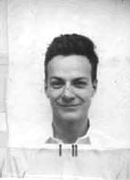Richard Feynman
Richard Feynman (1918-1988) was a leading American physicist and educator based at Caligfornia Institute of Technology. He played a major role in shaping modern quantum physics, computer design, and nanotechnology. He attracted a following for his collgege lectures on physics, which he published, and for his iconoclastic personality. He popularized physics with many short essays and talks, often talking about the pranks he loved to play.
He credits his education in reading an encyclopedia when he was young, at the insistence of his father.[1] After studying at M.I.T. and Princeton University, he assisted in the development of the atomic bomb at Los Alamos.
Feynman's major contribution was to quantum electrodynamics. He introduced the diagrams, now called Feynman diagrams, which are used to describe the behavior of systems of interacting particles. He was awarded a Nobel Prize for Physics in 1965. He worked on the problem from 1939 to 1947, confronting two puzzles that were the source of the difficulties with quantum electrodynamical theories. The first was an infinite energy of interaction of the electron with itself. And this difficulty existed even in the classical theory. The other difficulty came from some infinites which had to do with the infinite numbers of degrees of freedom in the field. His solution, while still an undergraduate, was that electrons cannot act on themselves, they can only act on other electrons. That was not quite right, but as a graduate student, with help from his mentor, Princeton Professor John Wheeler, he did figure it out.[2]
Inquiring mind
Feynman was famed for his uncanny ability to cut to the heart of a problem with novel approaches. Feynman liked to tell a story about how when he was a little kid, he asked his father, "Why do things fall?" As an adult, he praised his father for answering, "Nobody knows why things fall. It's a deep mystery, and the smartest people in the world don't know the basic reason for it." Contrast that with the average person's off-the-cuff answer, "Oh, it's because of gravity." Feynman liked his father's answer, because his father realized that simply giving a name to something didn't mean that you understood it. [3]
Challenger investigation
He had a leading role in the investigation of the crash of the space shuttle Challenger [4]).
Feynman cut through the red tape and figured out what caused the Challenger disaster.
- I took this stuff that I got out of your seal and I put it in ice water, and I discovered that when you put some pressure on it for a while and then undo it, it doesn't stretch back. It stays the same dimension. In other words, for a few seconds at least and more seconds than that, there is no resilience in this particular material when it is at a temperature of 32 degrees.
His style of investigating with his own direct methods rather than following the commission schedule put him at odds with Rogers, who once commented, "Feynman is becoming a real pain." During a televised hearing, Feynman famously demonstrated how the O-rings became less resilient and subject to seal failures at ice-cold temperatures by immersing a sample of the material in a glass of ice water.[5]
Feynman was so critical of flaws in NASA's "safety culture" that he threatened to remove his name from the report unless it included his personal observations on the reliability of the shuttle. He argued that the estimates of reliability offered by NASA management were wildly unrealistic, differing as much as a thousandfold from the estimates of working engineers. "For a successful technology," he concluded, "reality must take precedence over public relations, for nature cannot be fooled."[6]
- NASA officials argue that ... since the Shuttle is a manned vehicle "the probability of mission success is necessarily very close to 1.0." It is not very clear what this phrase means. Does it mean it is close to 1 or that it ought to be close to 1?" ==Books==
- Surely You're Joking, Mr. Feynman! - his personal and academic life up to the 1960s
- What Do You Care What Other People Think? - half the book is about the Challenger disaster
- QED- A accessible explanation of quantum electrodynamics written for a layman.
- The meaning of it all- A book of philosophy.
- The Pleasure of Finding Things Out: The Best Short Works of Richard P. Feynman (2000) excerpt and text search
"The Development of the Space-Time View of Quantum Electrodynamics", his Nobel Prize Lecture, 1965
Notes
- ↑ Review of Classic Feynman: All the Adventures of a Curious Character, by R.P. Feynman by Robert Matthews [1]
- ↑ see "The Development of the Space-Time View of Quantum Electrodynamics", his Nobel Prize Lecture, 1965
- ↑ Lectures in Physics: The Motion of Falling Objects. Lectures on Physics is based on the series by Benjamin Crowell, "Light and Matter". (This is a secondary source.) [2]
- ↑ Feynman What Do You Care What Other People Think?: Further Adventures of a Curious Character [3]
- ↑ Gleick, James (1988-02-17). Richard Feynman Dead at 69; Leading Theoretical Physicist. New York Times. Retrieved on 2007-01-28.
- ↑ Feynman, Richard P. (1986) http://history.nasa.gov/rogersrep/v2appf.htm Appendix F - Personal Observations on Reliability of Shuttle]
